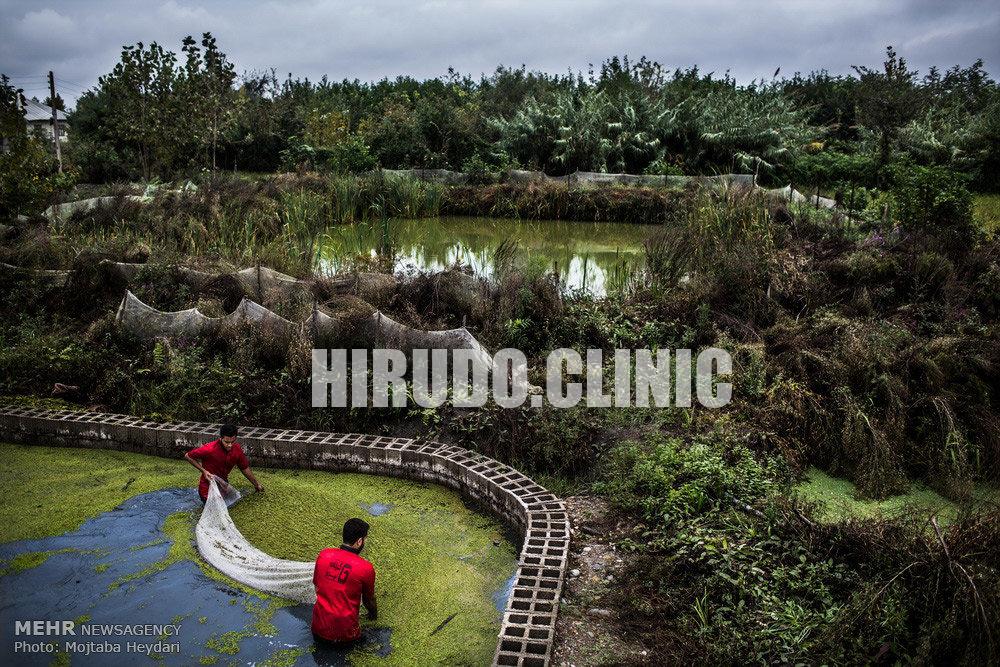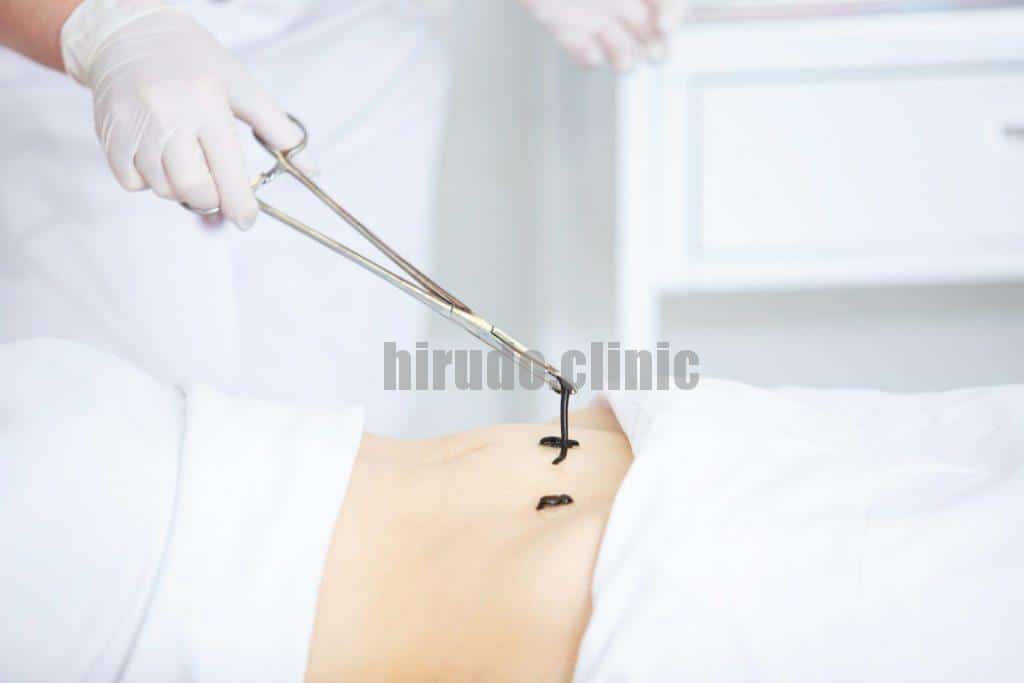At Hirudo.Clinic, we honour the ancient tradition of leech therapy while embracing modern, nature-based practices. Our high-quality organic leeches, cultivated in open ponds under controlled conditions, are known to contain higher levels of beneficial enzymes, including the powerful anticoagulant hirudin.
🌿 The Healing Power of Organic Medicinal Leeches
While all leeches are technically organic beings, the term “organic leeches” refers to those raised in semi-natural, outdoor aquatic environments—as opposed to sterile lab settings. These environments mimic natural ecosystems, allowing leeches to absorb natural solar and earth energies, feed on organic materials, and interact with rich microbial life.
Key benefits of organic leeches:
- Higher concentration of therapeutic compounds
- Richer levels of hirudin, produced by gut flora
- More resilient, effective leeches for healing sessions
💉 What is Hirudin?
Hirudin is a naturally occurring anticoagulant secreted by medicinal leeches during therapy. It prevents blood clotting, supports microcirculation, and encourages detoxification.
Studies suggest that leeches grown in outdoor, nutrient-rich conditions may produce more hirudin, due to exposure to beneficial microbes and natural feeding cycles.
🌊 How Are Organic Leeches Raised?
Leeches are cultivated in clean, sunlit freshwater ponds with precise control over:
- pH, temperature, and oxygen levels
- Organic feeding (animal-based materials)
- Regular monitoring to ensure therapeutic quality
This method enhances the biological vitality of the leeches, making them more effective in clinical applications.
🏥 Why Choose Hirudo.Clinic?
We offer medicinal leech therapy in London, Surrey, and Dubai, using only certified, high-quality leeches from verified farms. Our services include:
- In-clinic and at-home sessions
- Online consultations and training courses
🧑⚕️ Book a Session or Consultation
Ready to experience natural rejuvenation? Try our organic leech therapy and feel the difference. Contact us today or book online.
🌐 www.hirudo.clinic
📩 [email protected]
🧪 Leeches: Content Differences Between Organic vs. Conventional
1. Enzyme Concentration
- Organic leeches may contain higher levels of active enzymes, such as:
- Hirudin – a powerful anticoagulant that prevents blood clotting.
- Bdellins & Eglins – anti-inflammatory and analgesic compounds.
- Destabilase – helps dissolve blood clots and improves circulation.
- These increased levels are thought to result from:
- Exposure to natural microbes.
- Varied organic feeding.
- Less sterilized, more ecologically rich environments.
2. Gut Microbiota Diversity
- Leeches raised in open pond environments develop a more diverse internal microbiome.
- Gut flora contributes to the synthesis of therapeutic compounds like hirudin.
- Lab-raised (non-organic) leeches may have reduced microbial diversity due to sterile conditions.
🌿 Why Farms Use the Term “Organic Leeches”
1. Natural Aquatic Environment
- Leeches are raised in semi-natural ponds, exposed to sunlight and natural sediments.
- Water is filtered but not sterilized, mimicking a natural habitat.
- The goal is to stimulate their biological development naturally, rather than artificially.
2. Organic Feeding Practices
- They are fed on organic animal blood or tissue rather than synthetic substitutes.
- No chemical additives, antibiotics, or growth stimulants are used.
3. Sustainability & Ethics
Emphasizes ecological responsibility and therapeutic purity.
The “organic” label appeals to patients seeking natural, holistic therapies.
Farms use the term to differentiate from industrial-scale, lab-raised leech production.
Развивая целительную силу природы: Искусство разведения органических пиявок в открытых прудах
🌿 Organic Leech Pond Cultivation
The cultivation of leeches in open ponds involves creating a controlled aquatic environment that closely resembles their natural habitat. These ponds are filled with fresh, clean water and are often situated in areas with ample sunlight. Leeches are introduced into this environment, where they can absorb natural energies from the sun and earth. Water quality is strictly monitored to maintain optimal conditions, including temperature, pH, and dissolved oxygen levels. Leeches are fed organic materials, such as animal blood or tissue, and their growth and development are carefully tracked. This innovative farming method yields stronger and more effective leeches, which are richer in beneficial enzymes and bioactive compounds.
🗺️ Medicinal Leech Farms in Europe
While many traditional ponds have declined due to habitat loss and historical overharvesting, a small but dedicated number of farms across Europe still maintain and breed medicinal leeches—often for medical use in clinics, research, or conservation efforts:
- Wales (UK): Swansea’s Biopharm company manages the only major modern leech supply operation in the world. Farm-raised leeches are kept in carefully controlled tanks and fed blood-filled sausages. This operation supplies leeches to the NHS and international clients PMC+14Science History Institute+14ResearchGate+14.
- Conservation Sites in Scotland: While not farms in the traditional sense, projects in places like Islay, Oban, and Dumfries & Galloway are working to reintroduce and breed wild medicinal leech populations in natural ponds. These efforts involve raising leeches on deer blood in sausage casings, monitoring reproduction, and carefully selecting new habitats for translocation Epochmagazine.
- General Context Across Europe: Medicinal leeches (species such as Hirudo medicinalis, H. verbana, H. orientalis) once thrived in natural wetlands across Europe, but have suffered steep declines due to habitat destruction. Overharvesting in the 19th century, followed by widespread drainage of eutrophic ponds, led many populations to become endangered or legally protected Wikipedia+4MDPI+4ResearchGate+4.
Overall, natural populations remain fragile and rare, making organic and well-maintained ponds essential for both therapeutic use and ecological preservation.
Open-pond cultivation mimics natural ecosystems to enhance leech vitality and therapeutic compound levels.
In modern Europe, commercial farming is limited (notably in Wales), while important conservation breeding sites operate in parts of the UK.
🐍 How Long Can Medicinal Leeches Survive Without Feeding?
Medicinal leeches can survive for several months without food due to their ability to slow down metabolism and conserve energy. However, it’s important to note that extended periods of starvation can negatively affect their health, vitality, and therapeutic effectiveness.
To maintain their medical-grade quality, leeches should be fed regularly, especially when kept for long periods before therapeutic use.
The exact length of time a leech can survive without feeding depends on several factors, including:
- Age
- Size
- Activity level
- Environmental conditions (temperature, oxygen, etc.)
For optimal care, it is highly recommended to consult an experienced specialist regarding proper feeding schedules, storage conditions, and general leech husbandry practices — especially in medical or clinical settings.
🧪 Fasting as a Form of Biological Sterilization in Medicinal Leeches
Organic medicinal leeches can go without feeding for up to six months before therapy. During this time, leech farmers intentionally keep them unfed to prepare them for medical use. This fasting process helps clear their digestive systems, lowers microbial content, and ensures each leech stays clean and safe for therapeutic application.
Keeping leeches unfed serves as a natural form of biological sterilization — allowing their digestive systems to clear out residual blood, reduce microbial content, and ensure they are safe, clean, and ready for medical use.
This approach enhances both the purity and safety of the leeches, especially for clinical applications where hygiene is critical.

Свяжитесь с нами, чтобы заказать этот пакет и получить натуральное лечение на высшем уровне удобно у себя дома.
Farms specializing in the breeding of medicinal leeches (often referred to as hirudotherapy farms) are located in various parts of the world.

France has a rich history in medicinal leech use, having been the global leader in both consumption and farming during the 1800s. At the height of the “leech boom,” the country imported tens of millions of leeches annually for medical purposes. Today, this legacy continues through RICARIMPEX, a specialised farm based in Gironde, which stands as France’s only major producer of medicinal leeches. The facility cultivates approximately 110,000 leeches (Hirudo verbana) each year, supplying a range of clients — from hospitals and licensed medical professionals to private clinics across Europe.
- Россия и Восточная Европа: Этот регион имеет долгую историю использования пиявок в медицинских целях. В России популярность гирудотерапии растет, и по всей стране есть фермы и терапевтические центры.
- Турция: В Турции также есть фермы, специализирующиеся на разведении лечебных пиявок.
- США: Несмотря на то что использование пиявок в США менее распространено, чем в Восточной Европе или России, в стране есть фермы, которые производят лечебные пиявки. В США пиявки в основном для медицинских и исследовательских учреждений.
- Китай: Традиционная китайская медицина ценит пиявок, и в Китае также есть фермы и терапевтические центры.


